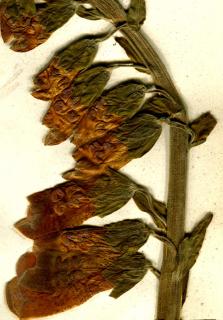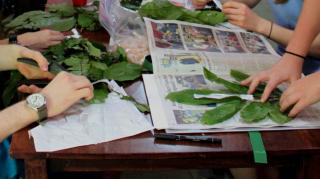Bursting with unspent energy, children are probably among those who suffer most during these times of confinement.
Spring is already there, and the weather is good. Why not keep children busy in the garden with a project they’ve probably never done yet: a herbarium!
Children’s herbarium quick facts
Made from – all garden plants
Difficulty – easy with guidance
Time required – 1 week
Suitable for – children 6+
Season – spring, summer
Read also:
Herbarium, a fun activity with lots to teach
What is a herbarium?
- It’s a book (or a binder). On each page, the author describes a plant: a tree leaf, garden flower, root… Plant parts are flattened, dried, and pasted to the page.
- A single plant species is described per page. Next to the plant itself, the collector writes the date and the place of harvest. After that, the common name and scientific name of the plant is marked. Additional notes include uses of the plant, what makes it stand out, how it smells, and other personal observations.
Did you know? Each plant part folded into the book is called a “specimen“.
A great activity to do with kids during a lockdown
 Now that parents must become teachers, creating a herbarium helps in several respects. It offers children an opportunity to discover and understand the plant world, all the while having lots of fun!
Now that parents must become teachers, creating a herbarium helps in several respects. It offers children an opportunity to discover and understand the plant world, all the while having lots of fun!
- This activity is suited to children of all ages. It doesn’t require much equipment. You’ll enhance many of your child’s abilities: observation, creativity, concentration, patience, and even vocabulary.
- A herbarium is never truly finished. This activity can last for the entire quarantine, right when nature is most buzzing with life.
- Colors, plants and fragrances burst forth and change as spring turns into summer.
Did you know? Some schools may provide extra credits for children who have worked on preparing a herbarium!
Create a herbarium with your children
Equipment needed for the herbarium
 Secateurs for plants, and a pair of scissors
Secateurs for plants, and a pair of scissors- Pouches or containers for the harvest
- Labels to mark the plant specimens
- Thick paper pages and a binder. A simple notebook will also do fine.
- Newspapers or magazines
- Plywood or a pile of heavy books
- Plastic pouches (those used to slide documents in for protection)
- Color pencils
- Scotch tape
Collecting plants in the garden
Collect plants in dry weather. Make sure to use secateurs or sturdy scissors to cut the stems, for a clean cut.
Place each specimen in a different pouch or container (flowers, leaves, fruits, roots, etc). Try to identify the plant and write the name on a label. Common name, and, if possible, botanical name, too.
Tip on how to identify plants
Other options are to look plants up in encyclopedias, on the Internet, or to show the plants to grandparents on video call!
Lastly, excellent initiatives such as Plantnet and iNaturalist will help identify more difficult specimens.
Drying plants
- Place each plant between two newspaper or magazine pages.
- Weigh it down to flatten it with the plywood or the heavy books.
- Check on the drying process from time to time (it takes a few days).
Placing the plants on the page
- Carefully lift the dried plants and place them on the sheets of thick paper. Try to make it look nice. Place only one type of plant per page. Keep some space for the notes you’ll be writing.
- Fasten the plant parts to the page with scotch tape.
Archiving each page
- Slide the pages with plants on them in the clear plastic pouches, and store it in the binder.
- Place plants of the same family next to each other.
A chance to keep in touch
To make sure friendship and family bonds develop, have the children share about their herbarium through the internet. They can show their work to friends and family with webcams and social media. That way they can swap ideas and compare their findings during the entire summer and spring.
Give all children weekly challenges:
 Find and collect the most colorful plants in the garden, or the most surprising, or the ones with the roundest leaves…
Find and collect the most colorful plants in the garden, or the most surprising, or the ones with the roundest leaves…- Meeting up through these “webconferences” with friends on a regular schedule will structure their day.
- It’s a great way to learn about how unique the vegetation in your area is!
Lydie Droite
Read also:


 Now that parents must become teachers, creating a herbarium helps in several respects. It offers children an opportunity to discover and understand the plant world, all the while having lots of fun!
Now that parents must become teachers, creating a herbarium helps in several respects. It offers children an opportunity to discover and understand the plant world, all the while having lots of fun! Secateurs for plants, and a pair of scissors
Secateurs for plants, and a pair of scissors Find and collect the most colorful plants in the garden, or the most surprising, or the ones with the roundest leaves…
Find and collect the most colorful plants in the garden, or the most surprising, or the ones with the roundest leaves…